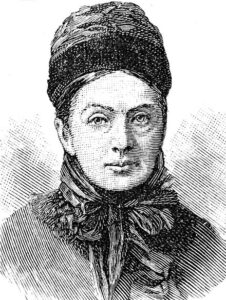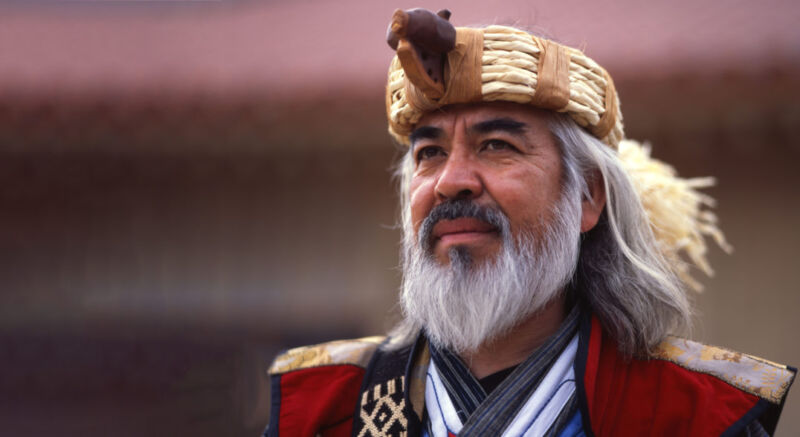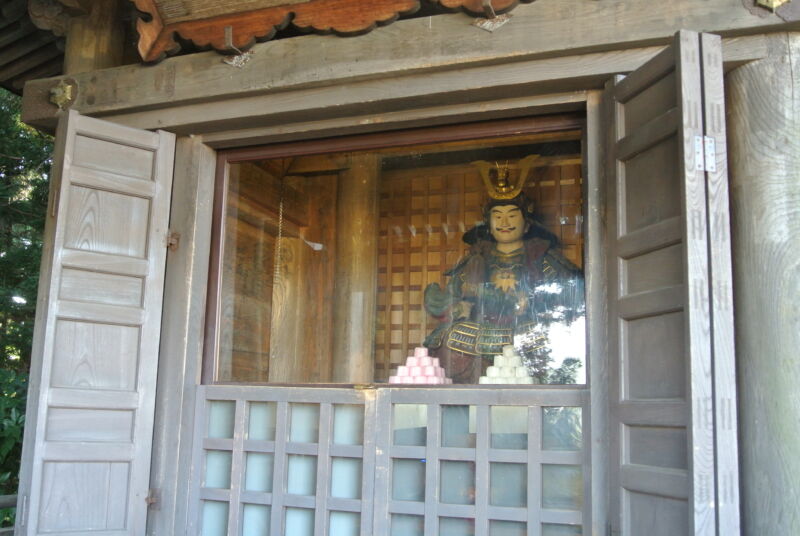
The Ainu religion dates back further than Shinto and has much in common. Indeed, it’s sometimes said that it was the basis from which Shinto developed. The similarities are at once apparent for the Ainu worshipped kamuy, invisible spirits that equate to kami.
Due to suppression by the Wajiin or Yamato Japanese, the Ainu religion is no longer practised in the way it once was, but we can get a feel of the traditional way of life thanks to the amazing Isabella Bird (1831-1904). This extraordinary adventurer made a journey in 1878 to Japan, during which she travelled with a Japanese attendant into Ainu-occupied Hokkaido.
She visited several villagers, stayed in Ainu houses, and took part in the Ainu way of life, including their religious rites. These are written up in a detailed account of her visit, which begins with the introduction below to an Ainu hillside place of worship. (pages 251-2 in the Doverbook paperback edition). Remarkably it’s for Yoshitsune, a Japanese warrior of the twelfth century. How extraordinary, one might think, but it turns out Isabella Bird was quite mistaken as shown by the passage by John Batchelor which follows hers. In fact she might well have been the victim of a piece of misinformation by the Ainu designed to deceive the Wajin (Yamato Japanese). Please be sure to read both passages….
*****************

On the very edge of the cliff, at the top of the zigzag, stands a wooden temple or shrine, such as one sees in any grove, or on any high place on the main island [Honshu], obviously of Japanese construction, but concerning which Ainu tradition is silent. No European had ever stood where I stood, and there was a solemnity in the knowledge. The sub-chief drew back the sliding door, and all bowed with much reverence. It was a simple shrine of unlacquered wood, with a broad shelf at the back, on which there was a small shrine containing a figure of the historical hero, Yoshitsune, in a suit of tarnished brass candlesticks, and a coloured Chinese picture representing a junk. Here, then, I was introduced to the great god of the mountain Ainus. There is something very pathetic about these people keeping alive the memory of Yoshtsune, not on account of his martial exploits, but simply because their tradition tells them that he was very kind to them. They pulled the bell three times to attract his attention, bowed three times, and made six libations of saké, without which ceremony he cannot be approached. They asked me to worship their god, but when I declined on the ground that I could only worship my own God, the Lord of Heaven and Earth and Heaven, of the dead and of the living, they were too courteous to press their request. As to Ito [her Japanese servant], it did not signify to him whether or not he added another god to his already crowded Pantheon, and he ‘worshipped’ i.e. bowed down, most willingly before the great hero of his own, conquering race.
*************
Later in a footnote, Bird explains that Yoshitsune was a hero of the Gempei War in the twelfth century and brother of Yoritomo, the barbarian quelling great general, and that he was forced into committing suicide by his brother suspicious of his popular appeal. “Many believe that he escaped to Yezo [Hokkaido], she continues, “and lived among the Ainu for many years, dying among them at the close of the twelfth century. None believe this more firmly than the Ainus themselves, who assert that he taught their fathers the arts of civilisation, with letters and numbers, and gave them righteous laws, and he is worshipped by many of them under a name which signifies Master of the Law’.

******************************
In a revealing extract from his book on Ainu worship, the Anglican missionary John Batchelor provides a very different story from Isabella Bird’s account. Batchelor lived from 1877 to 1941 among the Ainu, and as such must be considered the leading authority on their spirituality. Fluent in Ainu, he was a fierce critic of Japanese cruelty to the people. (Thanks to Green Shinto reader, Joseph Cronin, for pointing out the passage below.)
………….
In the first place, it must be clearly understood that, when persons say the Ainu worship Yoshitsune, they mean not that people as a nation, but merely a few individuals resident in the Saru district. Again, it is not even asserted that all the Saru Ainu worship him, but only those of Piratori. Now, there are two Piratoris, viz. Piratori the upper, and Piratori the lower. These two villages were once united, but now are situated from a quarter to half a mile apart. The shrine of Yoshitsune (and there is but one shrine in Yezo) is at the upper Piratori, and the inhabitants of the lower village will tell an inquirer that it is the people of the upper Piratori who worship the person in question. Now, the upper village contains only thirty-two huts, and we find that not even ten persons out of these families really worship Yoshitsune. It is clear, then, that the Ainu, considered as a race or nation, do not at the present day deify that hero.Then, again, it should be noted that the present shrine is decidedly of Japanese make and pattern: in all respects it is like the general wayside shrines one may see anywhere in Japan. It was built about ten years ago by a Japanese carpenter resident at a place called Sarabuto (Ainu, San-o-butu). Previous to this there was also a Japanese-made shrine on the same spot, but a much smaller one. The idol in the shrine is both small and ugly; it is a representation not so much of a god as of a warrior, for it is dressed in armour and is furnished with a pair of fierce-looking, staring eyes, and has a horribly broad grin. It is just such an idol as one might expect in this case, seeing that Yoshitsune was a warrior. Besides this, the Ainus have treated the image to an inao or two. There is nothing more, and the shrine is too small for a person now, according to Ainu ideas and usages, it is necessary to turn to the east in worshipping God, the goddess of fire alone excepted. Hence the custom of building all huts with the principal end facing the east. But the shrine of Yoshitsune is placed in such a position that the worshippers would have to sit or stand with their backs to the east. The image of Yoshitsune is looked upon from the east; hence, speaking from analogy, it would appear that it is not the Ainu worshipping Yoshitsune, but either Yoshitsune worshipping the Ainu, or the Ainu insulting the Yoshitsune. Such a conclusion may appear far-fetched; but, in any case, the position of the shrine of Yoshitsune does not come up to the acknowledged requirements of the Ainu ideas of deity worship.
Again, the Ainu say that they would not worship an idol because it would be directly against the expressed command of Aioina Kamui, their reputed ancestor. The Ainu are, in many things, a very conservative people, and in the matter of religion particularly so. Note the following incident. In the days of the Tokugawa regime so runs the tale the Ainu were ordered by the Government, or rather by the authorities of Matsumai, to cut their hair in the Japanese fashion. The result was a great meeting of the Yezo chiefs, which ended in sending a deputation to beg that the order might be countermanded, or at least suffered to lapse. ‘For,’ say the Ainu,’ we could not go contrary to the customs of our ancestors without bringing down upon us the wrath of the gods.’ And though a few Ainu, particularly those at Mori, did cut their hair as ordered, the people as a whole were let off. If, then, a mere change in the fashion of cutting the hair was resisted, what would have been done to prevent the institution of idol-worship? Notwithstanding all this, there is still the fact to be accounted for that some Ainu state that Yoshitsune is worshipped by a few of their number, though very seldom. What is the explanation ?
An Ainu himself shall answer the first question. You know,’ says he, ‘we have for a long time been subject to the Japanese Tono Sama and Yakunin, and it has been to our interest that we should try to please them as much as possible, so as not to bring down trouble upon ourselves. As we know that Yoshitsune did come among our ancestors, it was thought that nothing would please the officials more than for them to think that we really worship Yoshitsune, who was himself a Japanese. And so it came to pass that the shrine was asked for and obtained.’
*********************
The above is taken from The Ainu of Japan (1892) and the extract can be accessed here. For an alternative version of the Yoshitsune story, see this Hokkaido Prefecture site which claims the warrior-deity was in fact foisted on the Ainu by Japanese newcomers. (With thanks to Joseph Cronin for pointing out this reference too.)

Wow, I’ve never heard of the Ainu religion, looks like I have some researching to do. Thanks again for sharing!
Yes, please enjoy your research but be advised that Isabella Bird’s passage about Yoshitsune as a deity is misinformed.
Thank you for your interest. For Joseph Campbell the antiquity of Ainu worship provided a window onto mankind’s earliest religions.